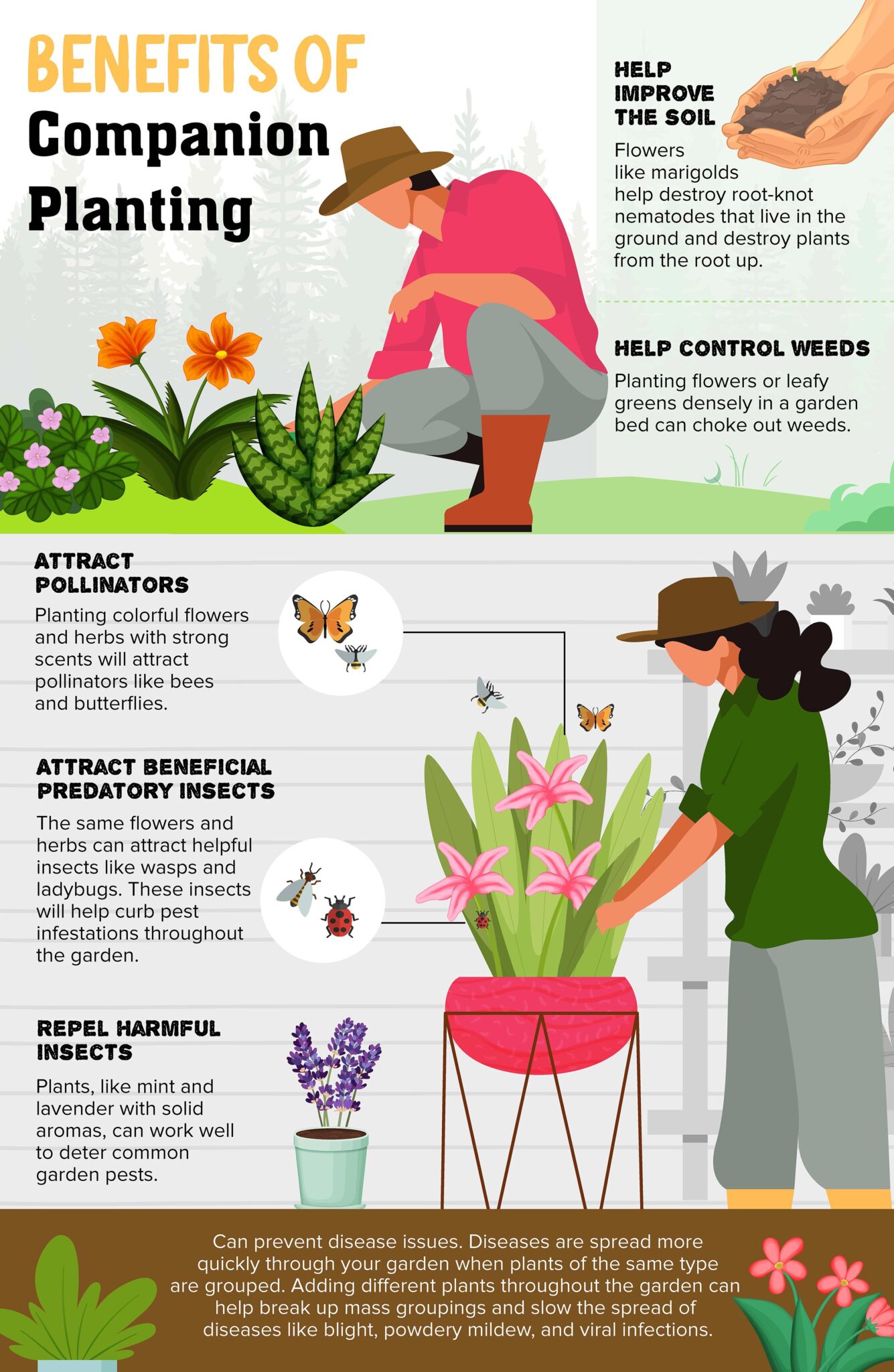The Ultimate Guide To Companion Planting
The Ultimate Guide to Companion Planting
Companion planting is a gardening practice that involves planting certain plants together to benefit each other. There are many different benefits to companion planting, including:
- Attracting beneficial insects and pollinators. Some plants attract beneficial insects, such as ladybugs and lacewings, which help to control pests. Other plants attract pollinators, such as bees and butterflies, which help to pollinate flowers and produce fruit.
- Reducing the need for pesticides. When you plant companion plants that attract beneficial insects, you can help to control pests naturally, without the need for pesticides.
- Improving soil health. Some companion plants help to improve soil health by adding nutrients, aerating the soil, or suppressing weeds.
- Disguising crops from pests. Some companion plants have strong scents or foliage that can help to disguise crops from pests.
- Improving crop yields. Companion planting can help to improve crop yields by providing shade, windbreaks, or support.
There are many different companion planting combinations that you can try. Some popular combinations include:
- Marigolds and tomatoes. Marigolds help to repel nematodes, which can damage tomatoes.
- Beans and corn. Beans fix nitrogen in the soil, which benefits corn. Corn provides support for beans to climb.
- Carrots and onions. Onions help to repel carrot fly, which can damage carrots.
- Cabbage and nasturtiums. Nasturtiums help to attract aphids, which would otherwise damage cabbage.
- Potatoes and beans. Beans fix nitrogen in the soil, which benefits potatoes. Potatoes provide shade for beans.
When choosing companion plants, it is important to consider the following factors:
- The plants' needs for sunlight, water, and nutrients. Make sure that the plants you choose will have similar needs, so that they will not compete with each other.
- The plants' growth habits. Some plants are tall and spreading, while others are short and compact. Make sure to plant tall plants behind short plants, so that they will not shade each other.
- The plants' pest and disease resistance. Some plants are resistant to pests and diseases, while others are more susceptible. Plant companion plants that have complementary pest and disease resistance, so that they can help each other to stay healthy.
Companion planting can be a fun and rewarding way to improve your garden's productivity and health. By taking the time to learn about which plants work well together, you can create a beautiful and productive garden that is naturally pest- and disease-resistant.
If you're looking to maximize your garden's yield and productivity, companion planting is a great way to do it. By planting certain plants together, you can create a symbiotic relationship that benefits both plants. For example, some plants attract beneficial insects that help to control pests, while others improve the soil quality or provide shade.
If you're not sure which plants are good companions for each other, there are plenty of resources available to help you out. One great place to start is Gardenia Inspiration. This website has a comprehensive companion planting chart that lists which plants are compatible with each other. You can also find information on the benefits of companion planting, as well as tips on how to implement it in your own garden.
So if you're ready to take your gardening to the next level, be sure to visit Gardenia Inspiration for more information about companion planting.
FAQ of garden planting companion guide
- What is companion planting?
Companion planting is the practice of planting certain types of plants together in order to benefit each other. Some companion plants can help to repel pests, attract beneficial insects, or improve the soil quality. For example, planting marigolds near tomatoes can help to deter pests such as tomato hornworms.
- How close should companion plants be planted?
The specific distance that companion plants should be planted apart will vary depending on the type of plants and the size of the plants. However, as a general rule of thumb, companion plants that have a beneficial relationship should be planted within two or three rows of each other.
- How many plants should a beginner have?
Experienced gardeners and growers suggest starting out with 2-3 different types of plants and then going from there. This will allow you to get a feel for gardening and see what types of plants you enjoy growing. As you become more experienced, you can gradually increase the number of plants you grow.
- What are some good companion plants for tomatoes?
Some good companion plants for tomatoes include basil, marigolds, nasturtiums, and chives. Basil helps to deter pests such as tomato hornworms, while marigolds and nasturtiums attract beneficial insects such as ladybugs and lacewings. Chives help to improve the soil quality and can also deter pests.
- Where can I find more information about companion planting?
There are many resources available online and in libraries that can provide you with more information about companion planting. Some good places to start include:
- The Companion Planting Guide: https://blog.jungseed.com/companion-planting-guide/ from Jung Seed
- Companion Planting: https://www.portlandnursery.com/veggies/companion-planting from Portland Nursery
- What should a beginner gardener plant?: https://www.homefortheharvest.com/what-should-a-beginner-gardener-plant/ from Home For The Harvest
Image of garden planting companion guide
5 different images of "garden planting companion guide" from Pinterest:
- Image 1: A colorful infographic that shows which vegetables and herbs are good companion plants for each other.

- Image 2: A photo of a garden bed with different vegetables and herbs planted together. The caption of the photo explains the benefits of companion planting for these specific plants.

- Image 3: A diagram of a companion planting wheel. The wheel shows which plants are compatible with each other and which plants should be avoided planting together.
- Image 4: A screenshot of a website with a list of companion planting tips. The tips include information on which plants attract beneficial insects, which plants repel pests, and which plants improve soil quality.

- Image 5: A book titled "The Vegetable Gardener's Companion Planting Guide." The book cover features a photo of a garden with different vegetables and herbs planted together.
Post a Comment for "The Ultimate Guide To Companion Planting"